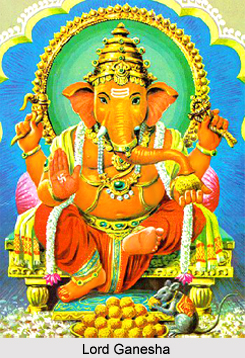 The legend of Lord Ganesha and King Kanakavarsa is mentioned in the Kathasaritsagara which is a compilation of various legends and folktales from India. The Kathasaritsagara is an 11th century work composed by Somadeva, a Shaivite Brahmin. The popular Sanskrit work mentions that King Kanakavarsa desired to have a son. Thus, he prayed to Lord Kartikeya (Skanda) to bless him with a son.
The legend of Lord Ganesha and King Kanakavarsa is mentioned in the Kathasaritsagara which is a compilation of various legends and folktales from India. The Kathasaritsagara is an 11th century work composed by Somadeva, a Shaivite Brahmin. The popular Sanskrit work mentions that King Kanakavarsa desired to have a son. Thus, he prayed to Lord Kartikeya (Skanda) to bless him with a son.
Later Lord Kartikeya appeared before the king and asked him to worship and praise his elder brother Lord Ganesha who will bless Kanakavarsa with a boon to attain a son. Thus the king began to meditate for the elephant headed deity. The legend states that Lord Ganesha created several obstacles to hamper his meditation and tapas. The Lord created rain of venomous snakes but king Kanakavarsa remained unaffected. Lord Ganesha, also known as Vinayaka and Ganapati, then appeared before the king. The deity began to cause physical injuries to Kanakavarsa in order to stop him from performing his deep meditation.
The king thought of the deity to be an enemy as the Lord continued to create obstructions for him. But Kanakavarsa remained focused and was hard to suppress. He continued to worship and praise Lord Ganesha. Eventually the Lord became pleased with the devotion of King Kanakavarsa and appeared before him in His illustrious form. Ganesha finally granted the king his desired boon and soon a son was born to Kanakavarsa.
This article is a stub. You may enrich it by adding more information to it. You can send your write-up at content@indianetzone.com




















